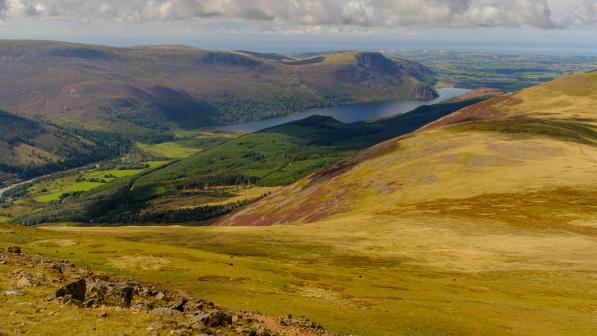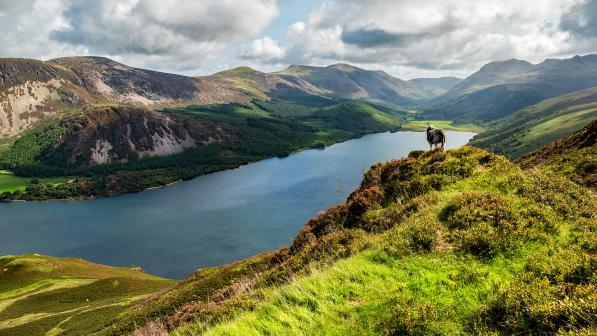Dartmoor: beastly bylaws rebound from 1998

Somewhere on the edge of Dartmoor on 23 August 1998, a Sunday, trailing a cluster of riders I could barely see in the clammy, twirling mists ahead, I resolved:
- Never to cycle uphill in clammy, twirling mists in thick jeans again
- To invest in a bicycle with working gears
- To work for the Cyclists’ Touring Club (CTC, now Cycling UK).
Unlike many – if not most – of my resolutions over the years, all the above materialised. But it’s Resolution No.3 that meant, and means, most to me.
Put another way, CTC’s protest against discriminatory bylaws on Dartmoor cast me into my cycle campaigning career, and I’ve never regretted it.
Why my bike and I went to Dartmoor
I went for the same reason that drew about 250 others to the moor that day. I can’t put it better than did Colin Palmer, our off-road advisor at the time:
“Intransigence on the part of the landowners, Devon County Council and the Government has led to cyclists being thrown off Dartmoor at a time when it is supposedly government policy to encourage cycling.”
The mechanism for throwing us off manifested as a new bylaw – back to Colin:
“[The bylaw’s] origins lay in the passing of the Dartmoor Commons Act in 1985. Previous to the Act, all walking, cycling and horse riding on Dartmoor was a civil trespass, but from 1985 walking and horse riding, but not cycling, became legal activities.
“Cycling subsequently continued on the moor at a low level, and with minimal fuss. However, the increasing popularity of the mountain bike during the late ‘80s and early ‘90s spurred landowners into requesting a bylaw to ban bikes on the commons. This was under a section of the Act which made provision to control any activity which was causing ‘serious problems’.
“The CTC, aided by the Central Council for Physical Recreation, vigorously opposed the bylaw on the basis that no serious problems had been identified.”
So, the bylaw banned cycling on the park’s common land on spec, not because of any evidence that it was causing problems. That didn’t seem at all right to me.
Not only that, but some of my best memories involved investigating Devon by bike in the early 1980s as a student at Exeter. I usually did that solo, taking my time. The red soil intrigued me, and I loved gazing over interleaving green and golden domes of land from the tops of hills up which I almost always walked. Yet, despite the frequent dismounting, I carried a CTC membership card, thanks to a persuasive pitch at the Freshers’ Fair.
But no walking up hills and gazing lingeringly on protest day, 1998. Our group had a rendezvous it couldn’t miss. In a pincer movement, we and other parties of cyclists, on-road and off-road, were all homing in on a highly classified location for a “symbolic mass trespass”, starting at 2pm.
The ride leaders had to get us all, including me and my rusty town bike, parents with toddlers on trailers, riders of tandems, recumbents and folders, plus all manner of other occasional or hardened riders, to the protest site on time.
Ambassador
This brings me to someone I’ve never forgotten.
By my side rode a cyclist I’d never met before, a member of what was then CTC’s Devon District Association (now a member group).
Sensing my struggles with the terrain and no doubt secretly appalled by my amateurish preparation for moor-riding, he shepherded me along, promised a break soon and, just as I was on the cusp of pleading to be dropped in the wilds, asked if I wanted a push. I said yes, so he let go of one his handlebars to propel me up all the remaining hills.
He was much older and fitter than me and now, twenty-four years later, I’m probably still a bit younger and less fit than he was then. What a perfect (and diplomatic) ambassador he was for our volunteers and the benefits of cycling.
The consequences of distraction
But this wasn’t just any cycle ride. It was, underneath it all, a CTC run. Quite rightly, the organisers had factored in a lunch stop at a 19th century hostelry.
All very nice. Beams, tankards, pewter platters, fireplace big enough to thaw hundreds of giant wolfhounds in winter; and, as it happens, a honeymoon memory for me.
This all added up to me not paying attention.
When I finally exited, one bike, and one bike only, stood outside. Mine. The others, steely in their purpose, had pressed on. Perhaps they’d decided the kindest thing was to leave me to dreamy recuperation on a settle with a fresh Devon ale. I can see why they might have thought that.
I had no map or directions. My peloton may have turned left from there, or right. The mission’s protesting nature meant that its precise destination had been divulged only on a need-to-know basis and, until then, I had not needed to know.
What to do?
Surrender after an ordeal launched with a pre-dawn “Be very, very careful on your bicycle, Cherry” from my mother on her Dorset cottage doorstep while my small daughters still slept upstairs?
What a cop-out. And how humiliating.
Just me and the panthers
So, now it was just me and the remote, moor-fringed fork in the road, more damp mists and, I am still convinced, some panthers. What better treat for a prowling beast than a distracted, lost, wilting cyclist separated from her pack?
I can’t fathom how I found the requisite venue on what is, to be fair, a very large moor. I have no idea how to navigate by the heavens or instinct and, even if GPS had been around for the likes of me then, it wouldn’t have helped as I’m no good at that either.
But, somehow, on time and much to the disappointment of all those salivating panthers, I discerned red, blue and yellow cycling jackets like beacons in fog, plus a banner reading:
‘WARNING! Cyclists, you are now criminals’.
Criminals
Criminals? Yes, those of us who’d crossed over the line into moorland on bicycles had turned into criminals.
Most carelessly, the bylaw had neglected to ban unicycles, making us protestors very happy for the three, star unicyclists weaving so lightheartedly amongst us.
But there’s one glaring question here, and it’s a tough one.
Let’s return to Colin Palmer, this time writing in our members’ magazine (now ‘Cycle’):
“But was it right for our 120-year-old club to step, for the first time, onto the wrong side of the law, in order to support an aggrieved cycling fraternity?”
This was no inconspicuous action. It was direct, high-profile and covered by BBC, ITV, the Times, Independent, Telegraph and, in full colour, by the Guardian.
We’d stepped outside the law very publicly indeed.
So, was it right?
In answer, Colin reminded readers of the Day of Action’s objectives:
- To raise public awareness over the injustice of the bylaws which discriminate against only one form of non-motorised users
- To put pressure on the National Park to negotiate with landowners for robust cross-moor routes for cyclists
- To put pressure on Government to influence a review of the bylaws
- To indicate to other agencies that considering similar procedures that the cyclist cannot be regarded as an easy victim.
I, for one, wouldn’t have joined the protest unless I’d been 100% behind all the above, especially the last. In no respect, I firmly believe, should cyclists be seen by any agency as easy victims.
Thirteen years of negotiation since the passing of the 1985 Act, moreover, had come to nothing. Feet, boots and hooves on the moor? No problem; come on in! Two wheels? Big problem; no welcome (nor evidence) here.
Crucially, CTC was at pains to stress that it wasn’t proposing the right to cycle anywhere on the moors. We were simply asking to access tracks, paths and areas suitable for cycle use.
And the ground bowling beneath my pedals on 23 August 1998 seemed not only rideable but also as unaffected by my tyres as a sturdy, low-pile carpet.
Why go down memory lane to Dartmoor now?
Dartmoor's bylaws brewed up for us again last year when the National Park Authority consulted on some proposed changes and, in our response, we recommended the removal of some of the discriminatory restrictions.
Now, with the final amendments due to be published this month, we should find out imminently whether 144-year-old Cycling UK needs to be as alarmed and aggrieved as 120-year-old CTC back in 1998. It's not impossible, in fact, that we might have to consider protesting on Dartmoor for a second time.
So, if you were involved in our protest twenty-four years ago, we would love to hear your recollections of the day, and indeed your comments on the current bylaws. Please do get in touch.
For the moment, though, I'll hand you over to Kieran Foster and my other campaigning colleagues for all follow-ups and leave you with this thought: it’s time to help extinguish these beastly bylaws of Dartmoor for good.








